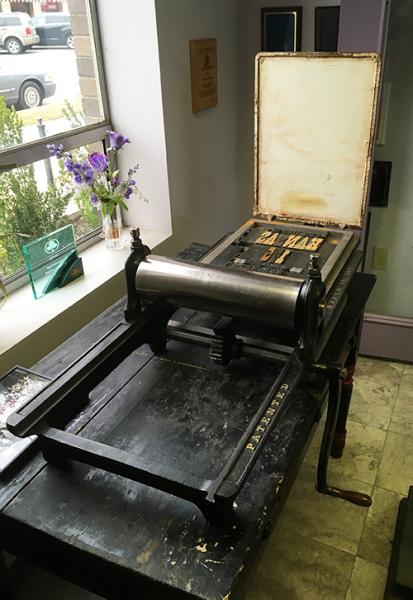ADAMS COTTAGE (Civil War Army) PRESS
Sometimes I’ll help a guy liquidating his equipment. Often I can successfully pair him up with someone who’s told me they’re looking, or find a buyer by listing it locally. I have a friend who’s closing down his print shop & has asked me to sell his Letterpress equipment. I’ve had some of his stuff listed with Briar & locally in KC and much of it has sold at realistic prices in spite of the seller’s intention to get the best market value.
Normally I have no problem pulling together some reasonably-credible market-based estimates from the internet but the No.5 Adams Cottage Press has virtually no track record of auction or other sales results to go by. For an item this obscure, an auction would be the best test but the owner has no faith in auctions & has stipulated that we find a buyer some other way.
This is one of the Adams presses Utah Steve Pratt reproduced from a recasting of an 1861 original. As I understand it, a dozen were produced but sold only as raw unmachined castings along with blueprints for the cylinder, tympan & other moving parts. Steve Pratt kept & machined one of the iron press castings for himself and then shaped all the needed steel bits & pieces in his own machine shop. It’s very nicely finished. The press pictured is Steve Pratt’s own Adams press. He later sold it to the Wamego, Kansas Museum of Printing. They sold it to the current owner about 10 years ago. It has gotten very little use over its entire life.
There are so many significant factors to consider. It’s a repro, sure, but a very special repro & expertly finished. It’s a difficult press to find either way. It’s the largest Adams of this type made but light enough for one or two people to move easily. It’s in terrific, barely-used condition.
I’m a mite embarrassed (albeit shamelessly) to show-up here with a fishing pole, but I’m at an impasse. And to be clear, I’m not looking for bids, just a spitball as to what would be a figure in the range of reason.
My sincere thanks for your wisdom & insight.
Calvert Guthrie
Kansas City

AdamsCottage3LR.jpg

AdamsCottage2LR.jpg

AdamsCottage1LR.jpg
i am curious how the press operates. Can you describe or possible post a video?
thanks
LD
Have you already looked on-line for some demo footage?
It’s essentially the same mechanism as a Poco or an intaglio press. The shop is currently closed & the press may’ve been moved but if not, the next time I meet with the owner, I’ll see if I can get him to hold the camera for a moment.
A Youtube search took all of two minutes.
https://www.youtube.com/watch?v=ywk6OyPxHWg
LD, I’m not the original poster, but I think I can answer your question. The bed rolls under the cylinder like a lithography press. I believe the cylinder is free-turning and simply operates via friction with the forme. There’s a rack and pinion system under the bed to drive everything. You can see the pinion gear in the second and third photos, attached to the handle’s shaft. The rack sticks out past the bed at both ends of the travel, so that the bed completely clears the cylinder and allows the tympan and frisket to open. You can see it’s extension mated with the pinion gear in the second photo.
So basically, it operates kind of like a traditional common press. You open the tympan and frisket, ink the forme, place a sheet of paper onto the tympan, close the frisket over the paper and tympan and then the tympan over the forme, crank the bed under the cylinder and then back out again, open the tympan and frisket, remove the printed sheet, and start all over again.
Hopefully that’s reasonably clear!
—
Michael Hurley
Titivilus Press
Memphis, TN
Thanks, Michael !
CG
You’re welcome! One thing I notice in the video you posted is that the pressman is using more modern gage pins directly on the tympan and no frisket at all. I don’t think gage pins were invented until the 1880s and so would be a bit anachronistic with this press. Usually you would have used sharp pins (press points) pasted to the tympan to hold the paper in place while you closed the frisket. At most, you might have used card or leading pasted to the tympan. Not to say the gage pins don’t work by any means, it’s just not how the press was probably designed to be operated.
—
Michael Hurley
Titivilus Press
Memphis, TN
Michael - your explanation was crystal clear
Ragpicker - the video was quite good
LD
never heard about copies and documentation on sizes seem to vary down to 3x4 inch chase, definitely not many around.
value is hard to say the right collector would not pass on it.
I always wondered if this 3x4 was related to it.
81939988-EC26-431C-8C04-34371F49F28A_1_201_a.jpeg